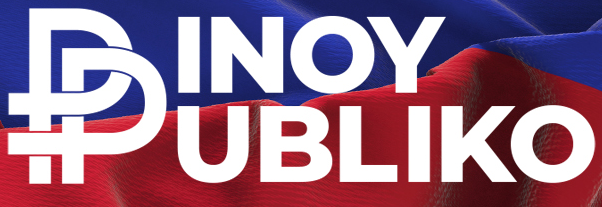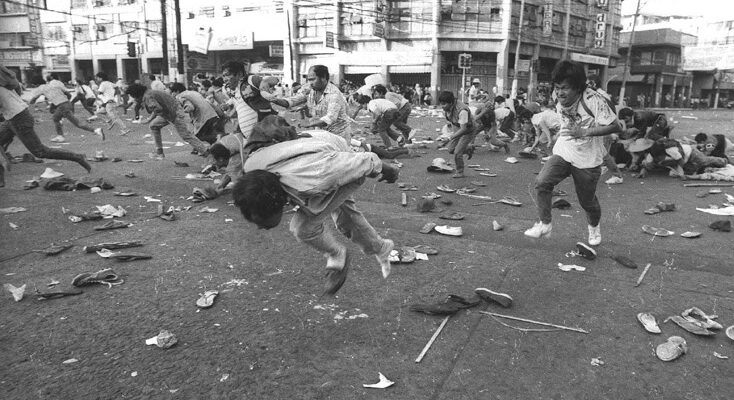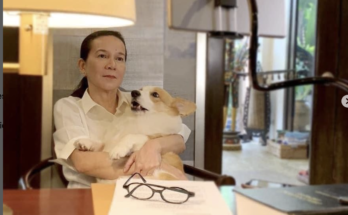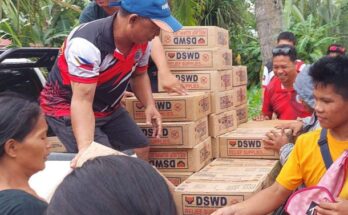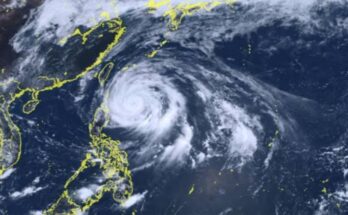THIS is the hitherto untold story of the fallen frontliners during the Mendiola massacre.
Thirty-six years ago.
Watching about 10 meters from where they stood, I personally witnessed the massacre of demonstrators at the foot of Mendiola Bridge.[1] Located in San Miguel, Manila, Philippines, Mendiola Bridge—a traditional site of protests—leads to Malacañan Palace. It is the seat of the presidency. It was late afternoon, Thursday, 22 January 1987.
For weeks, I had been covering the farmers’ mass sit-in in front of the Department of Agrarian Reform across the Elliptical Circle in Quezon City for Kalatas Paggawa (Labor Herald), a trade union workers’ publication.
From the very beginning, the scene at Mendiola Bridge was foreboding.
When I arrived, there were no barbed-wired barricades at the foot of the bridge, unlike during the other numerous demonstrations that I had covered there before. Yet, this was a major, massive mobilization. Instead, there were lines of Marines soldiers in full battle gear and armed with M16s right at the foot of the bridge.
I checked the area. Behind the Marines were a firetruck and a military truck. Television crews, police crowd dispersal units, and soldiers were there.
I made sure to go there earlier than the marchers. Earlier, at Liwasang Bonifacio—one of the converging points—several demonstrators dismantled the metal fence near the Post Office and grabbed its detached, broken steel bars.
The flatbed of the truck at Mendiola (where I briefly stood, held, and pulled up the hand of a female TV reporter to help her get on the truck), I thought was a relatively safe spot to be. The only thing that one might need to protect oneself from might be rocks that a strong demonstrator might throw. But I suddenly thought of Mateo “Mat” Vicencio, knowing how mobile, focused, and engaged he would be in coverage like this. Mat had our publication’s camera as he, aside from being a reporter, was our main photographer. I quickly jumped from the truck and hurriedly looked for him. We needed to observe our buddy system, our security protocol. Instead of coming with me to the truck, however, Mat said that he needed to cover Kilusang Magbubukid ng Pilipinas (Farmers’ Movement of the Philippines) spokesperson Jaime “Ka Jaime” Tadeo. With a sense of urgency, Mat told me—and with a tone of certainty—that Tadeo will be arrested (“Aarestuhin si Ka Jaime!”) during the negotiations between the demonstrators and anti-riot police. Mat wanted to capture that scenario on film. That spot was, if ever trouble broke out, along the direct line of fire.

Mat and I positioned ourselves at the frontlines of the demonstrators right where Tadeo was talking with the police officer in command of the phalanx of anti-riot police. Tension was high.
When I saw that their security cordon was signaled by the apparent team leader to pull Tadeo and the other mass leaders out, I knew instantly that skirmishes would break out right away. Given the mass of bodies, Mat and I were too far away to be able to squeeze our way through and go behind the government cordon. The Corona Book Supply store building to our right facing Mendiola was the closest spot we can go to for our safety, so I thought.
I firmly held Mat by the shoulders and pushed him against other shoving bodies towards the store. Mat and I were sandwiched and swept by bodies as the ranks of demonstrators darted, swarmed, pushed, and dashed toward the police and soldiers. Mat and I managed to inch our way only toward the gutter fronting the store, swamped by bodies from all directions.
Then sporadic bursts of gunfire rang out.
I instinctively shouted repeatedly, “Dapa! Dapa! Dapa!” (Drop to the ground!) and motioned to demonstrators with my two hands for them to drop to the ground. We were only able to crouch, half-bend our bodies as we were all lumped tightly together shoulder-to-shoulder in a vast sea of humanity.
All alert.
I looked up and around and scanned the surroundings. Amid the staccato of gunfire, a bullet whizzed near my scalp. I immediately dropped to the ground and saw that all the demonstrators around me were already on the ground. We were riveted to the ground as continuous, nonstop gunshots rang out. When I raised my head and looked around—as the hail of bullets intensified—the demonstrators disappeared from my sight. Suddenly, it was just Mat and me. I turned my head and saw only the tail end of the swarm of demonstrators scampering away along Legarda Street near the direction of the National Teachers College in Quiapo.
I found myself hugging the ground by the gutter, with Mat half-sitting in front of me. I was hoping we would not be hit, while psychologically preparing myself to be struck by a bullet or two or three at the same time, as bullets whizzed around us. I was hoping that if ever I got hit, it would be somewhere where I could still live and move actively as I wanted to continue with the work I was doing.
I was determined to survive.

A wounded protester is helped by a peasant activist after the shooting broke out. Photo courtesy of Ramon Acasio
I cannot see gunmen across the streets. Yet, I knew our position was vulnerable. We were at the gutter in front of Corona Book Supply. To my left, about two meters away, was a bloodied man, in a dirty white shirt, lying on his back. His arms raised, one higher than the other, asking for help. Farther away were three more bodies lying along Legarda Street, fronting Corona Book Supply. Unmoving. Thoughts raced in my mind. Bullets were whizzing all around us. If I reach out to him out there in the open street, I may be hit. Gunfire raged incessantly. If I took the risk and pulled him right where we were, I was not sure how safe he will be either, as gunmen could fire upon us. Our own position was vulnerable as well. Also, I thought: what will I do if I pulled him close to us by the gutter? I knew nothing about first aid. Hopefully, he would be safe where he was.
Uncertain as to where the other shooters were positioned, I pulled down Mat and shouted at him several times to drop to the ground; but he was immobile. He was taking pictures without looking through the camera lens. He was quietly clicking the camera that he held stably in his right hand that was lowered to his knee, close to the ground. That was the way Mat taught me to take pictures in situations where our own life was in peril: do not look through the lens, just point and continuously click until your last breath.
I quickly pulled Mat bodily with all the force I could muster towards the concrete wall of Corona Book Supply, hoping to protect both of us somehow from the direct line of fire. Our position was perpendicular to where the soldiers and police officers were positioned on Mendiola Bridge.
Across the streets, there were likely shooters who were not visible to us.
Single shots. M16s; automatic gunfire; not just one, not just two. Not just three.
The Sag-od and Escalante massacres of recent years raced through my mind. How could this be? At the heart of the city? The capital? Near Malacañan? Was it this worse during the First Quarter Storm?[2]
At the foot of Mendiola Bridge
Then, I noticed: Mat, I became alarmed, froze, his stare turned blank as gunpowder smoke hovered around. Teargas bombs exploded. He was mindlessly standing up, gazing at the unfolding carnage at the foot of Mendiola Bridge, visibly shocked, seemingly unaware of the staccato of gunfire that was whipping through the hazy late afternoon air. Seemingly unaware of the vulnerability of our position to gunfire. I kept pulling him down by his shoulders with my two hands, but he kept standing up. I had to eventually hold and forcefully and firmly pull down Mat by the back of his belt and denim pants to force him to crouch to the ground and avoid getting hit. His hands at one of the most critical junctures were down, not taking pictures as we journalists were supposed to. But reminding him about that was not an option at that moment. And instead, I made sure he and I will be both “safe”.
Moments later, I saw Mat taking pictures while he was (hopefully) safe enough in a squatting position. Not once did Mat drop to the ground. He either squatted or stood. Our gaze was both riveted towards the centerline at the foot of Mendiola Bridge.
We were speechless.
__
About the author: An award-winning investigative journalist and licensed attorney, Perfecto Caparas serves as a teaching fellow and founding director of the Center for Holistic International Human Rights Law Praxis of the National University of the Union of Myanmar-Burmese American Community Institute.

